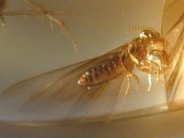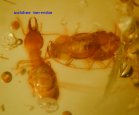|
Evolutionary
Origins of Eusociality in Insects
|
|
Also
see:
Tree of Life - Subphylum
Hexapoda
|
|
Prevalence
of Insect Eusociality
Eusociality
generally affords a great survival advantage to any group of
animals, and is likely best exemplified in insects. Behavioral
characteristics include the cooperative care of offspring,
distinct castes of workers (often sterile) that do not sexually
reproduce and groups that do, and well defined divisions of
labor. The behaviors of 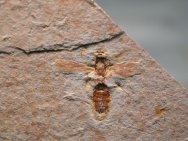 distinct groups are genetically coded,
and one caste has lost the ability to perform functions of
other castes. Eusociality is highly refined and abundant in
insect Order Hymenoptera (the ants, bees and wasps), as well
as in Infraorder Isoptera, Order Blattodea (the termites).
There are also eusocial, aphids, and thrips. However, there
is considerable differentiation between species in extent and
type of eusocial behavior. Among the hymenopterans, ants are
far and away the most social (almost all species), most having
highly refined labor division, and have even been noted for
collective colonial problem solving. Bees and wasps as a group
are far less social, with some highly social lineages, and
other lineages having entirely solitary behavior. The Isopterans
are highly eusocial, where a single king and queen perform
all reproduction, and there are castes of workers and soldiers. distinct groups are genetically coded,
and one caste has lost the ability to perform functions of
other castes. Eusociality is highly refined and abundant in
insect Order Hymenoptera (the ants, bees and wasps), as well
as in Infraorder Isoptera, Order Blattodea (the termites).
There are also eusocial, aphids, and thrips. However, there
is considerable differentiation between species in extent and
type of eusocial behavior. Among the hymenopterans, ants are
far and away the most social (almost all species), most having
highly refined labor division, and have even been noted for
collective colonial problem solving. Bees and wasps as a group
are far less social, with some highly social lineages, and
other lineages having entirely solitary behavior. The Isopterans
are highly eusocial, where a single king and queen perform
all reproduction, and there are castes of workers and soldiers.
Darwin's Problem and the Genetic Basis of Eusocial Traits
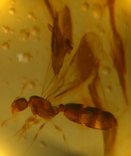 The
high prevalence of eusociality among hymenopterans compared
to its general rarity within the animal kingdom has been
an area of debate in evolutionary biology, and the new genomics
sequencing
technologies are enabling its study in detail. In a simple
view of Darwinian evolution, such altruistic self-sacrificing
of one’s
own genes could be viewed as contradictory. But, according
to Hughes (et al., 2008), eusociality evolved eight to ten
times
within Hymenoptera. In The Origin of Species, Darwin
described sterile worker castes in the social insects as "the
one special difficulty, which at first appeared to me insuperable
and actually fatal to my whole theory". The dilemma
has been explained by the concept of “inclusive fitness” a
combination of individual reproductive success and reproductive
success of a group having similar genes. In simple mathematical
terms, the portion of the altruist’s genes that are
passed on exceeds those that would be passed on in an individual
effort
to procreate. We now know it’s more complex than this
due to females having diploid cells (having two homologous
copies
of each chromosome, one from each parent), and males having
haploid cells (with but one chromosome). Consequently,
males share only
25% of their sisters' genes, whereas females on average share
50% of their sister's genes, which is the same as it would
be with their own offspring. Evolution will select for altruistic
cooperation
when it's
more efficient to raise siblings than offspring, providing
a sustainable selective
advantage of eusociality because the collective expends less
energy per offspring by its cooperative behaviors and division
of labor. The relatedness of sisters diminishes should the
queen not be sexually monogamous. Interestingly, many ants,
bees, and
wasps have evolved behavior of lifetime monogamy, where the
queen mates with one and only one male, who dies afterwards.
This monogamous trait is an ancestral characteristic
in all eusocial Hymenopteran lineages (Hughes, 2008). The
high prevalence of eusociality among hymenopterans compared
to its general rarity within the animal kingdom has been
an area of debate in evolutionary biology, and the new genomics
sequencing
technologies are enabling its study in detail. In a simple
view of Darwinian evolution, such altruistic self-sacrificing
of one’s
own genes could be viewed as contradictory. But, according
to Hughes (et al., 2008), eusociality evolved eight to ten
times
within Hymenoptera. In The Origin of Species, Darwin
described sterile worker castes in the social insects as "the
one special difficulty, which at first appeared to me insuperable
and actually fatal to my whole theory". The dilemma
has been explained by the concept of “inclusive fitness” a
combination of individual reproductive success and reproductive
success of a group having similar genes. In simple mathematical
terms, the portion of the altruist’s genes that are
passed on exceeds those that would be passed on in an individual
effort
to procreate. We now know it’s more complex than this
due to females having diploid cells (having two homologous
copies
of each chromosome, one from each parent), and males having
haploid cells (with but one chromosome). Consequently,
males share only
25% of their sisters' genes, whereas females on average share
50% of their sister's genes, which is the same as it would
be with their own offspring. Evolution will select for altruistic
cooperation
when it's
more efficient to raise siblings than offspring, providing
a sustainable selective
advantage of eusociality because the collective expends less
energy per offspring by its cooperative behaviors and division
of labor. The relatedness of sisters diminishes should the
queen not be sexually monogamous. Interestingly, many ants,
bees, and
wasps have evolved behavior of lifetime monogamy, where the
queen mates with one and only one male, who dies afterwards.
This monogamous trait is an ancestral characteristic
in all eusocial Hymenopteran lineages (Hughes, 2008).
Basic
Natural Selection in Evolution of Eusocial Altruism
The
above explains the genetic basis for eusocial behavior being
maintained
in a lineage, but how did it arise? That would
be
fairly straightforward natural selection. First, some advantage
was accrued by common nesting, and selected for. Mutations
and selection led to selective silencing of genes for individual
wandering (e.g., loss in wings in worker castes). Behavior
beneficial
to the queen’s reproduction is reinforced. Finally,
colonial lineages that are eusocial outcompete those that
are not.
Recent
Evolutionary Biology Studies of Eusocial Behavior, Enter
Sociogenomics
Recent
research has been powered by modern high-throughput molecular
technology that can quickly and inexpensively measure the
expression of all genes, or all protein, or entire genome
sequences, leading to dramatics new insights. Epigenomics
that studies the interaction of genes and environment has
been particularly important, as well as roles played by DNA
methylation, and microRNA-guided, novel post-transcriptional
modifications (i.e., same gene, but different resulting proteins).
A range
of finding have emerged in the last decade, such as:
1) Each eusocial insect lineage evolved from a solitary common
ancestor a species in which a single genome produced a single
adult
phenotype; 2) Transcriptomes studies support wasps as the
oldest eusocial group, with bees and ants having
branched from
the wasp lineage around 145 million years ago at the very
lowest Cretaceous Period; 3) Sociality started simple, but
became increasing complex as genomes were
further shaped and thus eusociality refined by natural selection,
where today some 14,000 eusocial
hymenopteran
species span a wide spectrum of eusocial behavioral traits;
4) some genes important in the eusocial phenotype lack homology
across species, indicating recent rapid evolution. As of
2014, entire genomes were available for 11 eusocial hymenopteran
orders.
Gene
expession
measurements
enable statistical
determination of which genes are likely involved in modulating
eusocial behavior, and which genes have been modified through
selection for different behavior.
Social
Insect Fossils
|
|
|
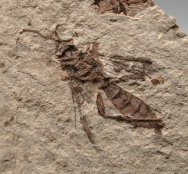 |
|
|
Flying
termite (or Alate) in amber.
|
Wasp
Lower Cretaceous
Liaoning Province, China
|
|
Soldier
termites in Colombian amber
|
|
References:
- Hughes,
W. O. H.; Oldroyd, B. P.; Beekman, M.; Ratnieks, F. L.
W. (2008). "Ancestral Monogamy Shows Kin Selection
is Key to the Evolution of Eusociality". Science 320
(5880): 1213–1216.
- G.E.
Robinson et al., “Sociogenomics:
social life in molecular terms,” Nat Rev Genet, 6:257-70,
2005.
- P.G. Ferreira et al., “Transcriptome analyses
of primitively eusocial wasps reveal novel insights into
the evolution of sociality and the origin of alternative
phenotypes.” Genome Biol, 14:R20, 2013.
- B.R. Johnson et al., “Phylogenomics
resolves evolutionary relationships among ants, bees, and wasps,” Curr
Biol, 23:2058-62, 2013.
- S.H. Woodard et al., “Genes involved in convergent
evolution of eusociality in bees,” PNAS, 108:7472-77 2011.
- B.R.
Johnson, N.D. Tsutsui, “Taxonomically restricted genes are associated
with the evolution of sociality in the honey bee,” BMC Genomics,
12:164, 2011.
- B. Feldmeyer et al., “Gene expression patterns associated
with caste and reproductive status in ants: worker-specific genes
are more derived than queen-specific
ones,” Mol Ecol, 23:151-61, 2014.
- S. Patalano et al., “Shifting
behaviour: epigenetic reprogramming in eusocial insects,” Curr
Opin Cell Biol, 24:367-73, 2012.
- H. Yan et al., “Eusocial
insects as emerging models for behavioural epigenetics,” Nat
Rev Genet, 15:677-88, 2014.
- R. Kucharski et al., “Nutritional
control of reproductive status in honeybees via DNA methylation,” Science,
319:1827-30, 2008.
- B.R. Herb et al., “Reversible switching
between epigenetic states in honeybee behavioral subcastes,” Nat
Neurosci, 15:1371-73, 2012.
- H.E. Amarasinghe et al., “Methylation
and worker reproduction in the bumble-bee (Bombus terrestris),” Proc
Roy Soc B, 281:20132502, 2014.
- A. Spannhoff et al., “Histone
deacetylase inhibitor activity in royal jelly might facilitate
caste switching in bees,” EMBO Rep, 12:238-43, 2011.
- D.F.
Simola et al., “Social insect genomes exhibit dramatic
evolution in gene composition and regulation while preserving
regulatory features linked to
sociality,” Genome Res, 23:1235-47, 2013.
- J.K. Greenberg
et al., “Behavioral plasticity in honey bees is associated
with differences in brain microRNA transcriptome,” Genes
Brain Behav, 11:660-70, 2012.
- L.G. Hernández et al., “Worker
honeybee brain proteome,” J
Proteome Res, 11:1485-93, 2012.
|
| |



